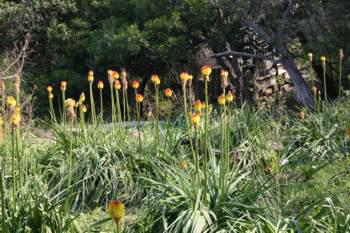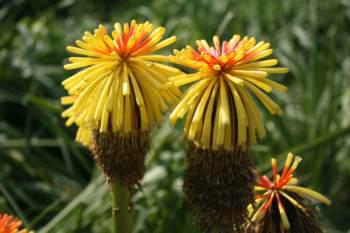Kniphofia rooperi
Kniphofia rooperi (T.Moore) Lem.
Family: Asphodelaceae
Common names: winter poker, Rooper's red-hot poker (Eng.); lentevuurpyl (Afr.); icacane (isiZulu)
Introduction
This evergreen perennial produces beautiful flowers with buds ranging from bright red to orange-yellow and the actual flowers ranging from orange-red to yellow-green during winter and early spring. It grows best in wetter areas.

Description
Description
Kniphofia rooperi is a robust, evergreen perennial, which grows in groups up to 1.4 m tall. The dull green, spreading leaves are deeply keeled (turning over on the sides) with toothed margins. The flowers appear as dense, round inflorescences. The stem is long and strong. The buds when young range in colour from bright red, orange-yellow or greenish. The flowers are about 42 mm long and range in colour from orange-red to yellow-green. Small round fruit follow the flowers.

Conservation Status
Status
LC (Least Concern) i.e. this plant is not in danger of extinction, but can be considered to be of conservation concern.
Distribution and habitat
Distribution description
These plants can be found in the marshy coastal areas of the summer-moist, Eastern Cape of South Africa. They need a moderate amount of water, although they can do well in very wet areas, providing that the soil drains well. They prefer warm, sunny conditions but can withstand light to moderately cold weather.

Derivation of name and historical aspects
History
Kniphofia rooperi belongs to the Asphodelaceae family which was formerly part of the Liliaceae family. It consists of mostly herbs but includes woody forms such as the tree aloe ( Aloe barberae). It is found in Europe, Asia and Africa where it is mostly centred in South Africa with Kniphofia and Aloe being the most prominent members. There are 17 genera in existence and approximately 750 species with 10 genera occurring in South Africa.
The genus Kniphofia is named after J.H. Kniphof, a professor of medicine at Erfurt University, born 1704, who died in 1763. The species name rooperi is named after Captain Edward Rooper who was stationed in East London in South Africa between 1848 and 1850. He was a painter of flowers and landscapes and was the one who sent this plant to England.

Ecology
Ecology
The nectar-rich flowers attract insects such as bees and butterflies.
Uses
Use
Traditionally the rootstock of Kniphofia rooperi was used as a good luck charm by African children. It is also used in traditional healing to treat chest complaints. It is also a good garden plant.
Growing Kniphofia rooperi
Grow
This evergreen, fast-growing perennial does best in sandy soil which is moist, but drains well. Enriching the soil with humus improves growth. It prefers full sun although it can tolerate semi-shade, but it may not flower as prolifically.

Plants can be propagated from seed, cuttings or by means of dividing. Seed should be germinated in a cold frame in spring. Established plants can be divided in late spring. One can also try cutting offsets away from the main clump with a sharp spade, especially in the case where the parent plant is old and woody. Leave them to grow on for a season or two before re-planting.
To ensure optimal and healthy growth it is important to clean the plant of dead and decaying leaves, as well as removing spent flower spikes. Ensure that they are taken out at the base. These flower spikes can cause nasty cuts when gardeners work with the plants and in addition could become a hiding place for pests such as earwigs and woodlice.
Where pests are concerned, these plants can be damaged by snails and slugs, as well as thrips which could cause mottling of the leaves.
Diseases that could prove to be a problem is violet rot if the drainage of the soil is impaired.
References
- Leistner, O.A. (ed.). 2000. Seed plants of southern Africa: families and genera. Strelitzia 10. National Botanical Institute, Pretoria.
- Pooley, E. 1998. A field guide to wild flowers Kwazulu-Natal and the eastern region. Natal Flora Publications Trust, Durban.
- http://www.telegraph.co.uk/gardening/howtogrow/3315599/How-to-grow-kniphofia.html
- https://www.rhs.org.uk/Plants/91833/Kniphofia-rooperi/Details
- http://www.smgrowers.com/products/plants/plantdisplay.asp?plant_id=2975
- http://www.plantstoplant.com/kniphofia-rooperi-agm-c2x9586337
Credits
Lou Nita Le Roux
Lowveld National Botanical Garden
December 2014
Plant Attributes:
Plant Type: Ground Cover, Perennial
SA Distribution: Eastern Cape
Soil type: Sandy, Clay
Flowering season: Spring, Winter
PH: Acid, Neutral
Flower colour: Green, Red, Yellow, Orange
Aspect: Full Sun
Gardening skill: Average
Special Features:
Horticultural zones










Rate this article
Article well written and informative
Rate this plant
Is this an interesting plant?
Login to add your Comment
Back to topNot registered yet? Click here to register.